Featured Comment:
“I made this as directed and it came out awesome. One of my fave comfort foods, now I know how to cook it myself. Mahalo!”
– Ma’ata
What is Miso Mackerel (Saba No Misoni)?
Saba no Misoni (Mackerel Simmered in Miso) is a classic Japanese fish dish where mackerel fillets are simmered in a rich broth made with miso paste, fresh ginger, and traditional condiments. The ginger and umami-rich sauce perfectly balance the mackerel’s robust flavor, creating one of Japan’s most beloved home-cooked meals.
When I lived abroad, I really missed that taste of home. I understand the challenge many face when trying to recreate authentic Japanese dishes abroad, unsure of how to prepare fish or achieve that perfect home kitchen flavor properly.
This recipe teaches you the essential techniques often missing from standard instructions, from the proper way to clean mackerel to the crucial timing of adding miso.
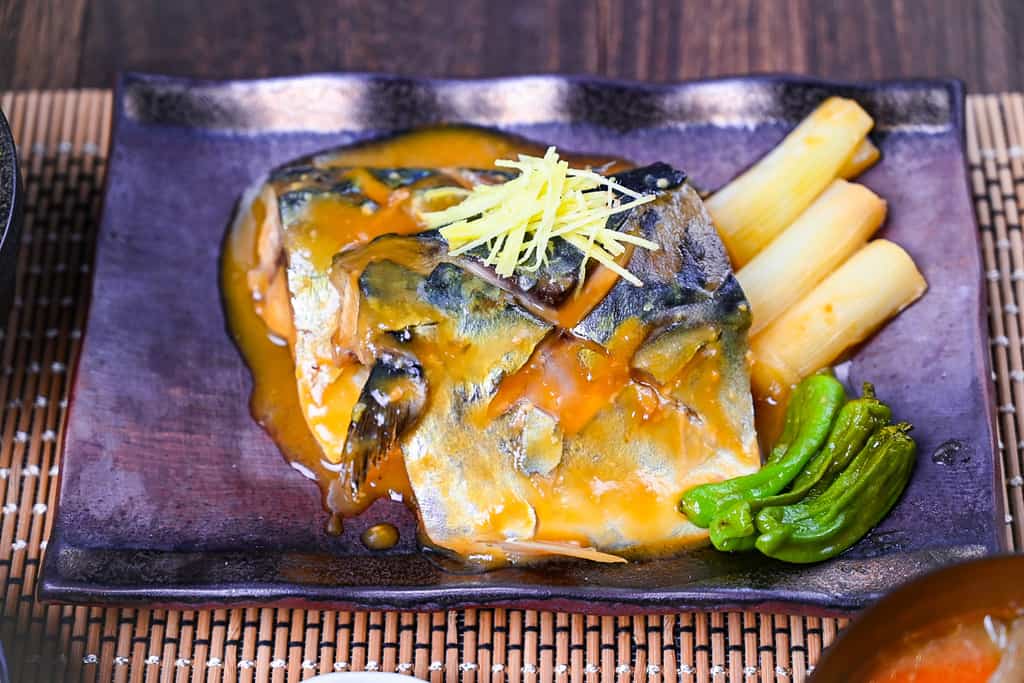
This dish pairs perfectly with steaming white rice as part of a traditional Japanese meal with soup, pickles, and side dishes.

Japanese-style teishoku (定食) set meals, with their thoughtful variety of components, not only nourish the body but also create that deeply satisfying experience that makes Japanese home cooking so special.
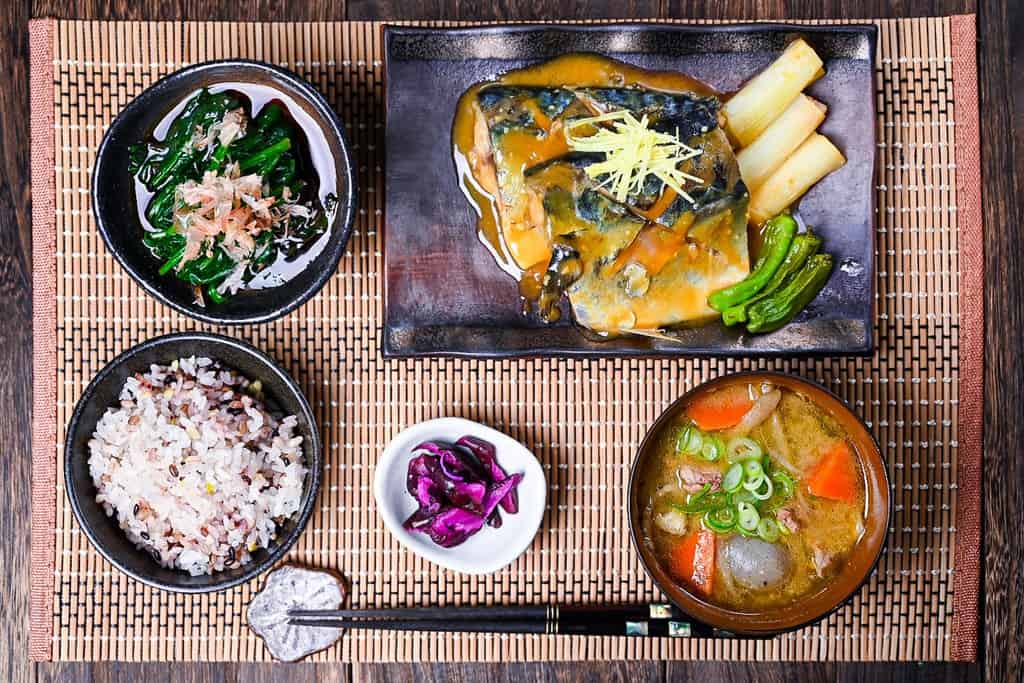
Ingredients & Substitution Ideas
- Mackerel Fillets: Chub mackerel, blue mackerel, and Atlantic mackerel are the most commonly used in Japan, but other varieties work well too.
- Sake: I always use unsalted drinking sake for cooking. If using cooking sake, adjust the salt content.
- Mirin: I recommend going for “hon mirin” (本みりん) for the most authentic flavor.
- Sugar: Regular sugar is fine, though I recently prefer light brown cane sugar.
- Awase Miso Paste: I recommend using Awase (blended/yellow) miso paste, as it is easy to use. You can also mix equal amounts of red and white miso.
- Fresh Ginger: Sliced and used to mitigate the fishy smell.
- Soy Sauce: If you’re looking for brand recommendations, I’ve put together a guide to soy sauce that you might find helpful.
- Japanese Leek: Cut into 5cm pieces. If you can’t get it, regular leek is completely fine.
- Shishito Peppers: It’s optional, but they add great texture and flavor.
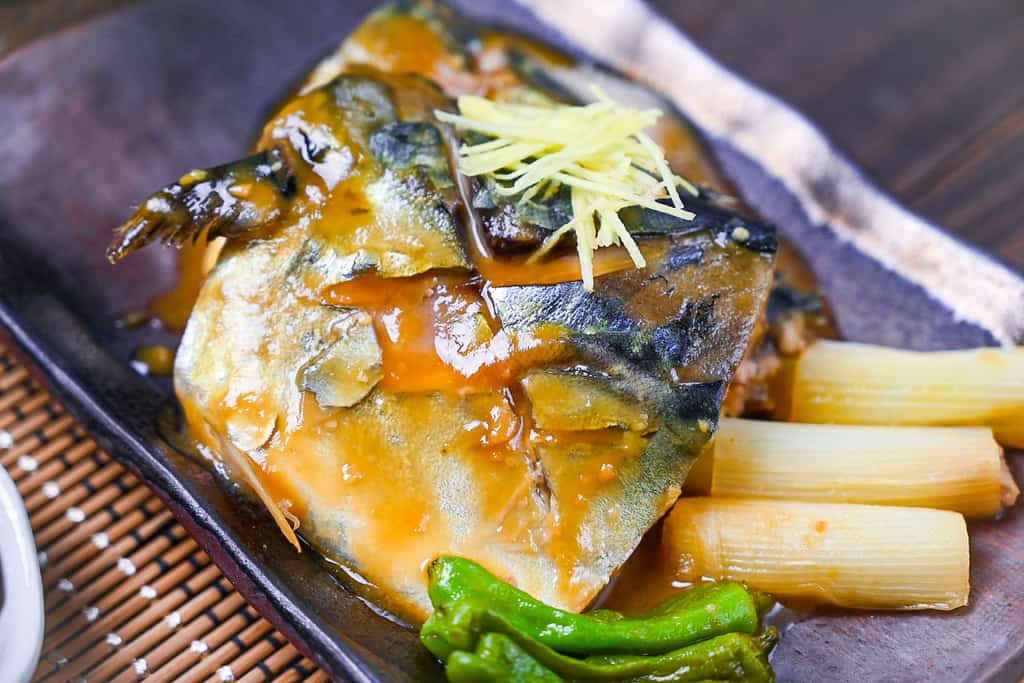
Visual Walkthrough & Tips
Here are my step-by-step instructions for how to make Miso Mackerel at home. For ingredient quantities and simplified instructions, scroll down for the Printable Recipe Card below.
Choose thick mackerel fillets with skin and bones. Look for fillets with a vibrant shine and firm flesh – these are signs of freshness. For serving size, aim for about 150-200g (5-7oz) per person. If the fillets are small, plan for two per person; if larger, one fillet is enough.
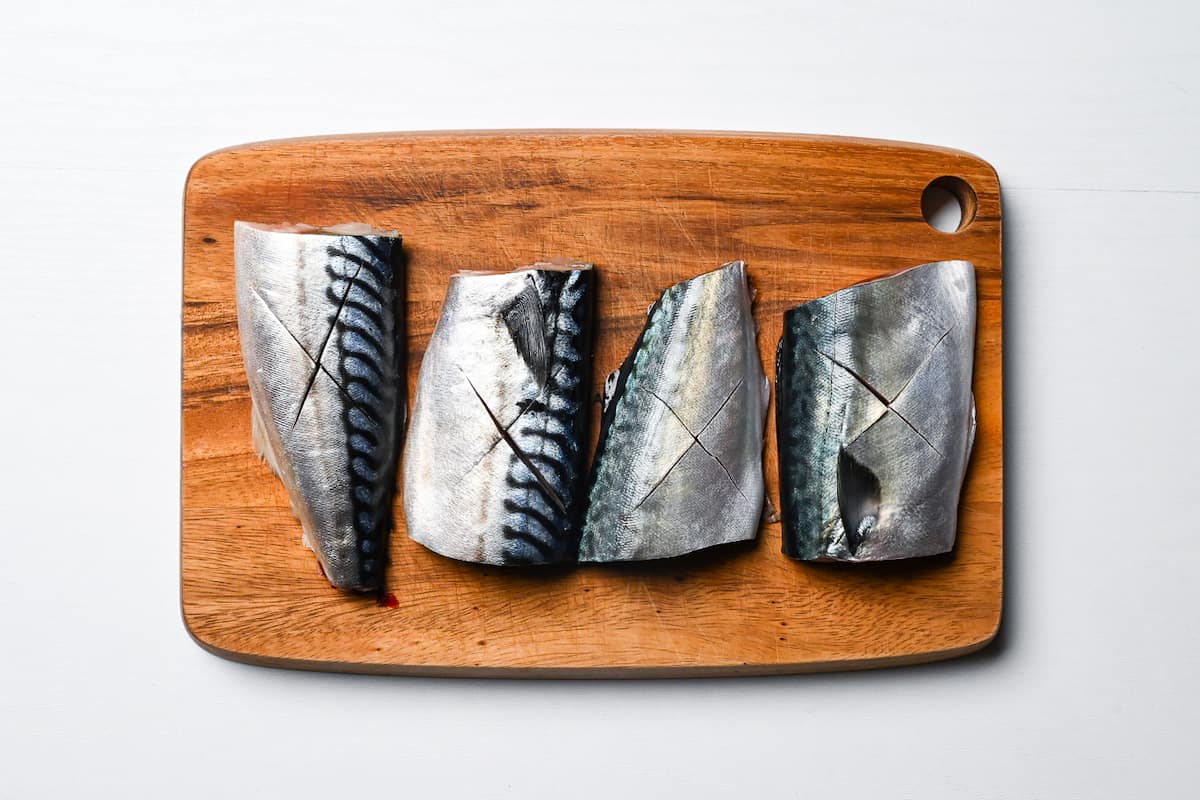
Scoring the skin side about 2mm deep is essential. This helps the heat circulate evenly and ensures the fish cooks properly. Remember, we don’t flip the fish during cooking for better presentation and even flavor absorption.
This kind of dish made with boney fish is one of the reasons why Japanese chopsticks are pointier than Chinese or Korean chopsticks. We use the chopsticks to carefully pick out the bones while eating!
Place the scored mackerel in a heatproof bowl. Pour boiling water over the fillets to loosen any debris, then quickly transfer them to ice-cold water.
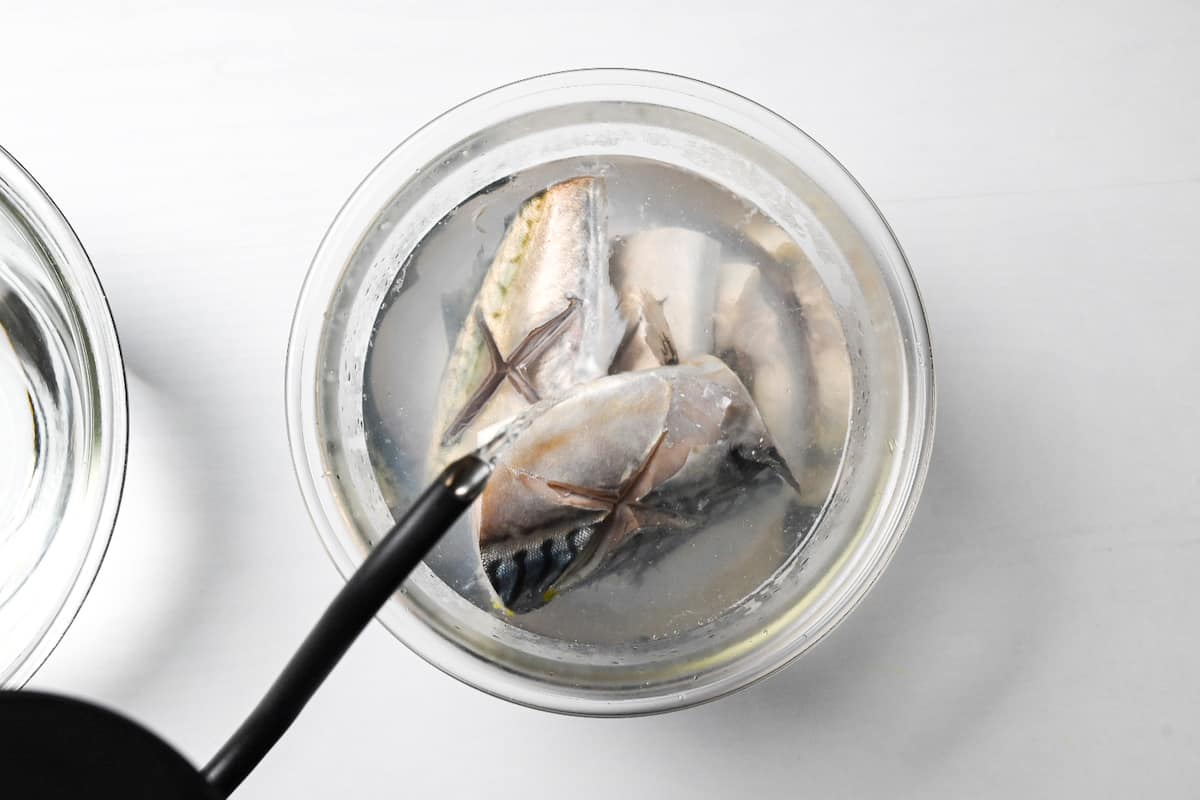
Shimofuri (霜降り) is a traditional Japanese cooking technique in which hot water is used to remove oils, blood, and slime that can cause fishy odors. This step is especially important for simmered dishes. The ideal time for this process is about 10 seconds, but you can adjust between 5-15 seconds depending on the size of your mackerel.
This sudden temperature change stops the cooking process and helps clean the fish without damaging the skin. When washing in ice water, pay special attention to the bloodline area (the darker meat) to more effectively eliminate sources of fishiness.
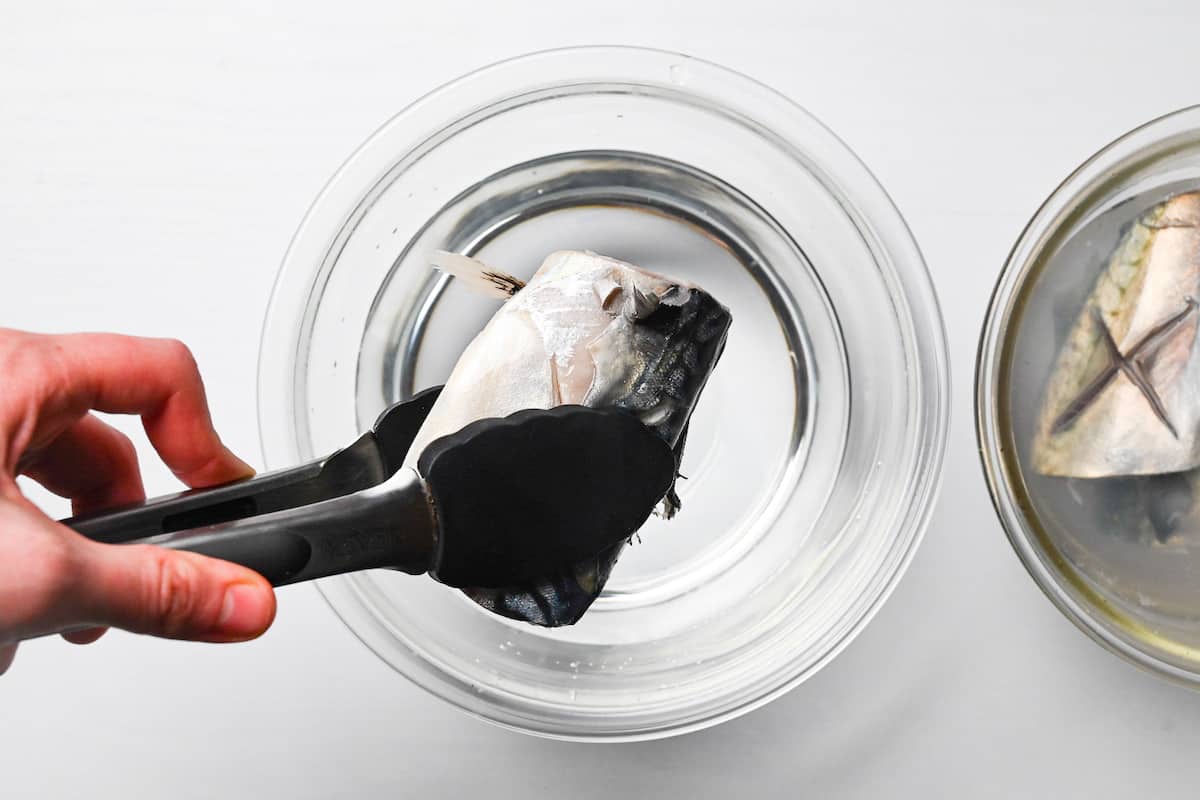
In addition, soaking the mackerel in cold water also tightens the flesh and prevents the good flavors from escaping when cooking.
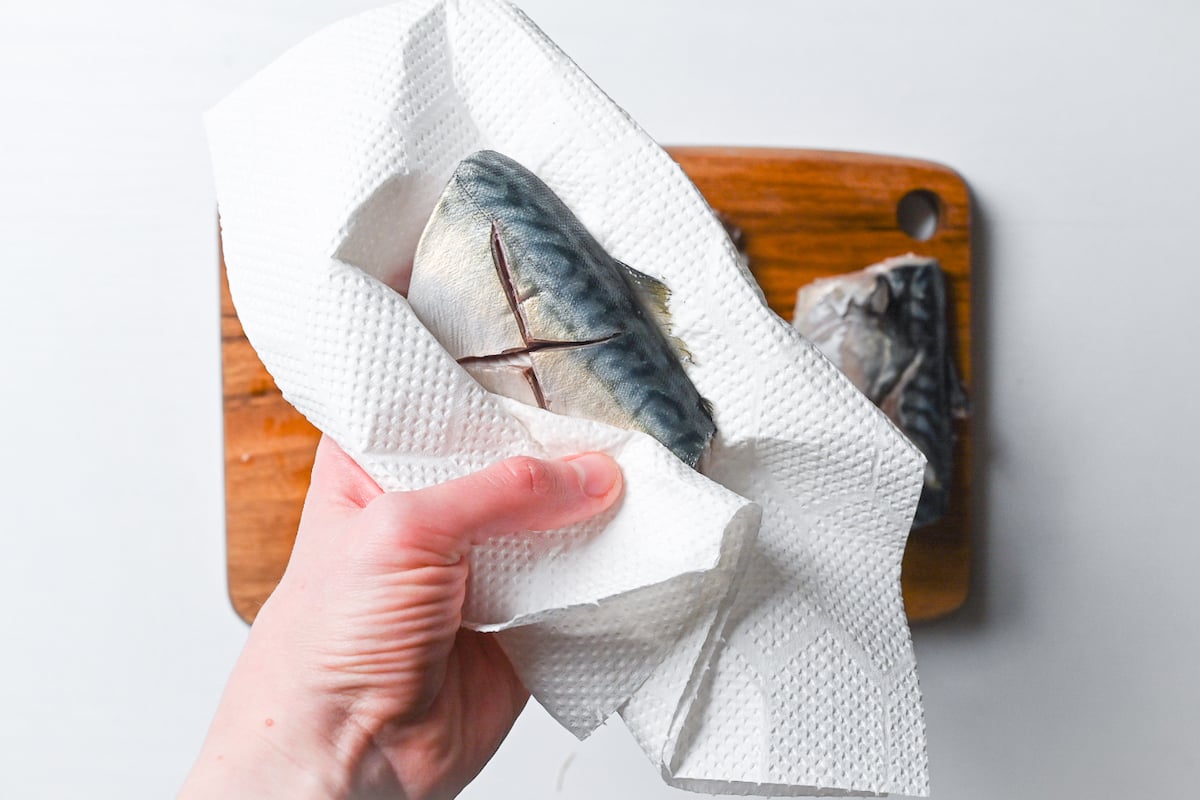
After cleaning, dry each fillet thoroughly with kitchen paper. This prevents any residual water from diluting the flavors in your broth.
In a large saucepan or pan, combine water, sake, mirin, sugar, and sliced ginger. Bring it to a boil, then reduce to a simmer.
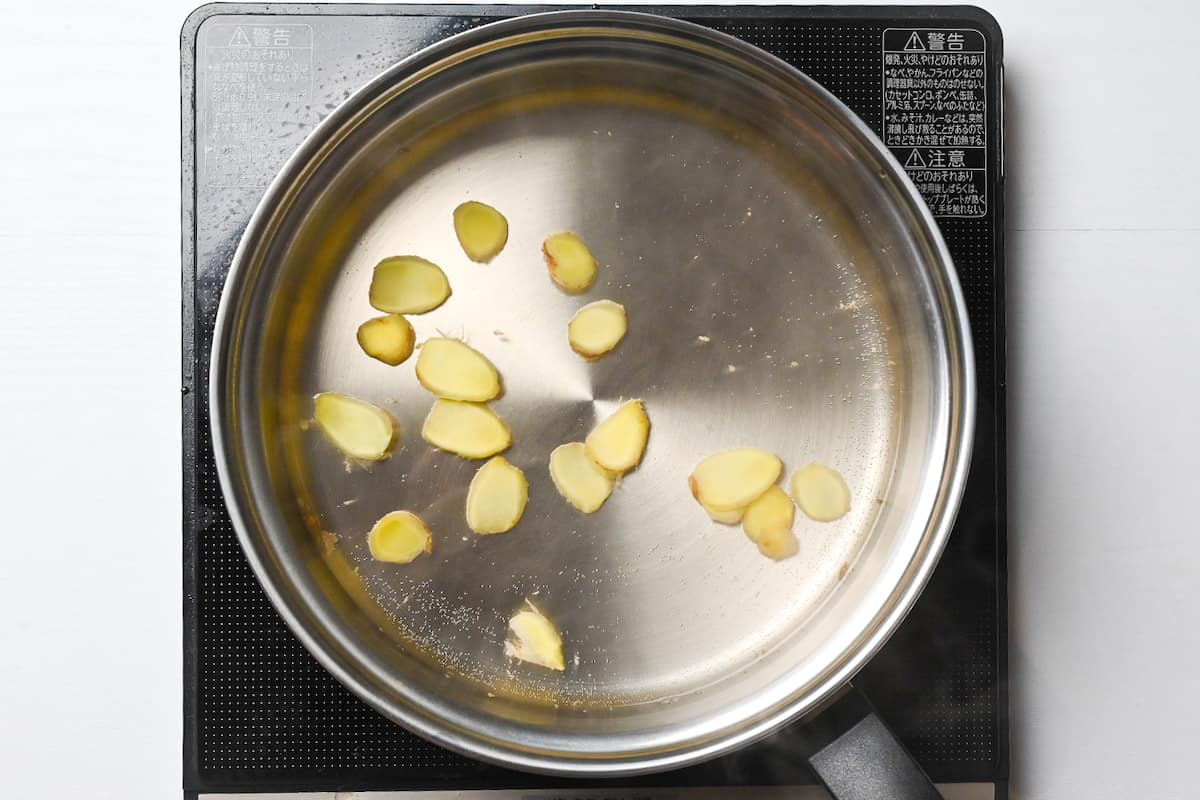
Add the mackerel fillets to the pan, skin side up. Spoon the broth over the top for 1-2 minutes.
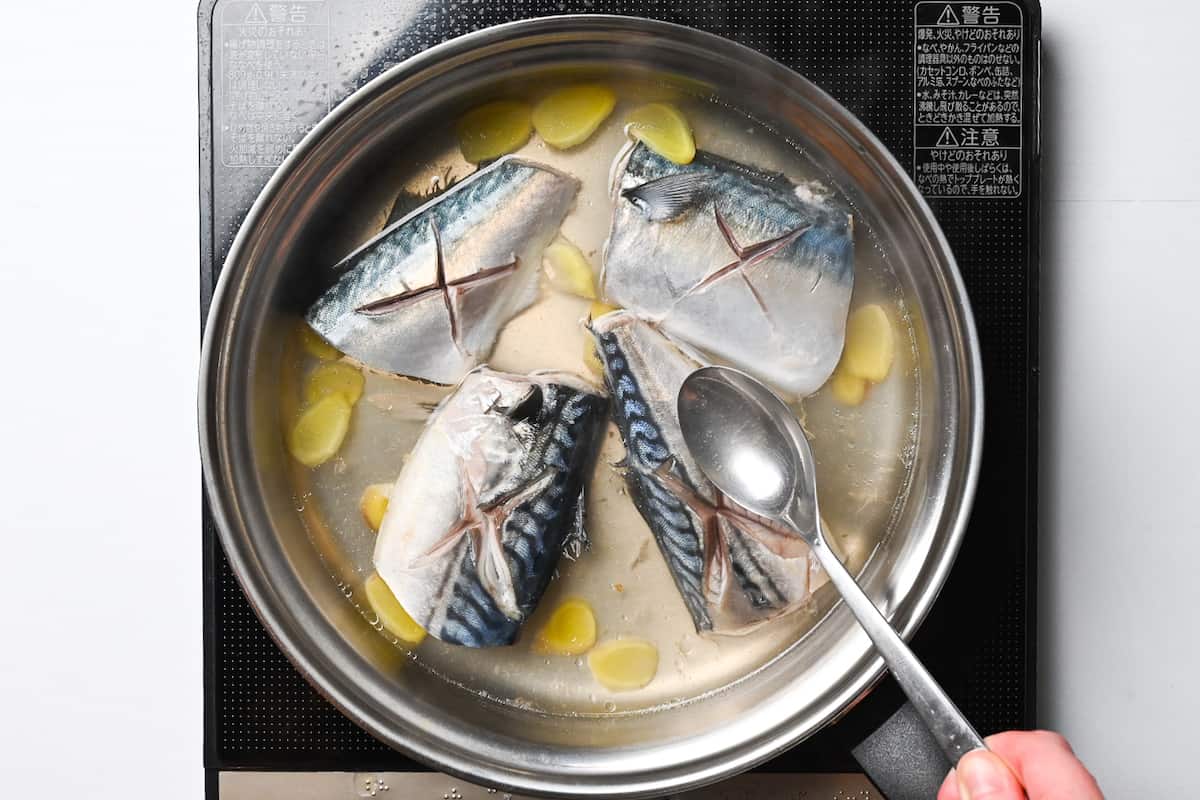
Even after washing, blueback fish (青魚), such as mackerel, can still have quite a strong flavor.This characteristic is balanced by the use of aromatics such as fresh ginger and leek, making your mackerel flavorful yet delicate!
Place a drop lid (otoshibuta) over the mackerel and simmer for 10 minutes. Not only does this prevent the surface from drying out, but it ensures even cooking and stops the fish from moving too much, therefore also preventing breakage.
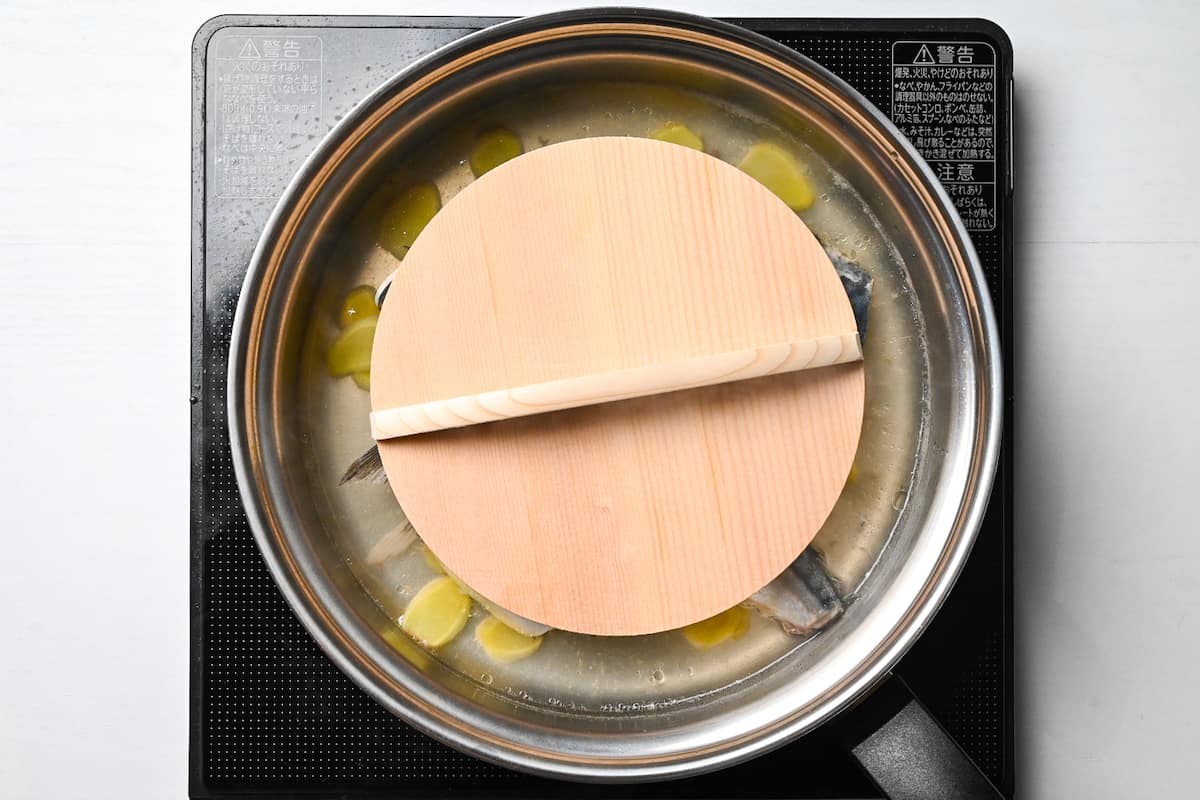
An otoshibuta is a Japanese cooking tool that sits directly on top of the ingredients in the pot. Using an otoshibuta allows flavors to penetrate evenly, reduces cooking time, prevents ingredients from breaking apart, and helps remove impurities.
While store-bought ones are made of stainless steel or wood, you can easily make one from aluminum foil or parchment paper cut slightly smaller than your pot with a small hole in the center for steam.
Miso paste doesn’t dissolve easily and needs to be mixed thoroughly. However, this dish doesn’t have much liquid, and thorough mixing might damage the fish.
In these cases, I use a small separate bowl and mix the miso paste with a small amount of broth from the pan (about 2 tbsp) and some soy sauce. You can then pour the mixture straight into the pan and over the mackerel – the thinned-out mixture will combine easily with the rest of the broth!
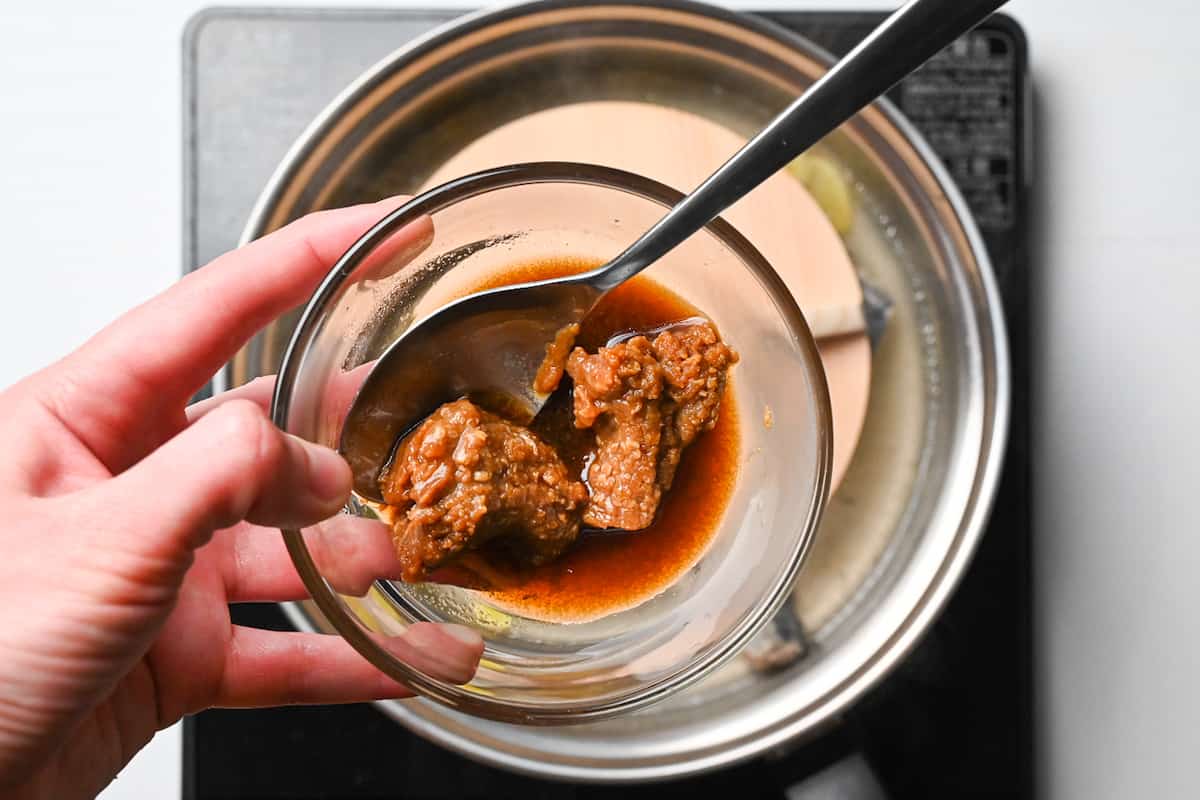
It’s also worth noting that miso paste tends to lose its flavor when cooked at high temperatures or for too long. For maximum flavor, I lower the heat to a simmer and add the miso paste near the end.
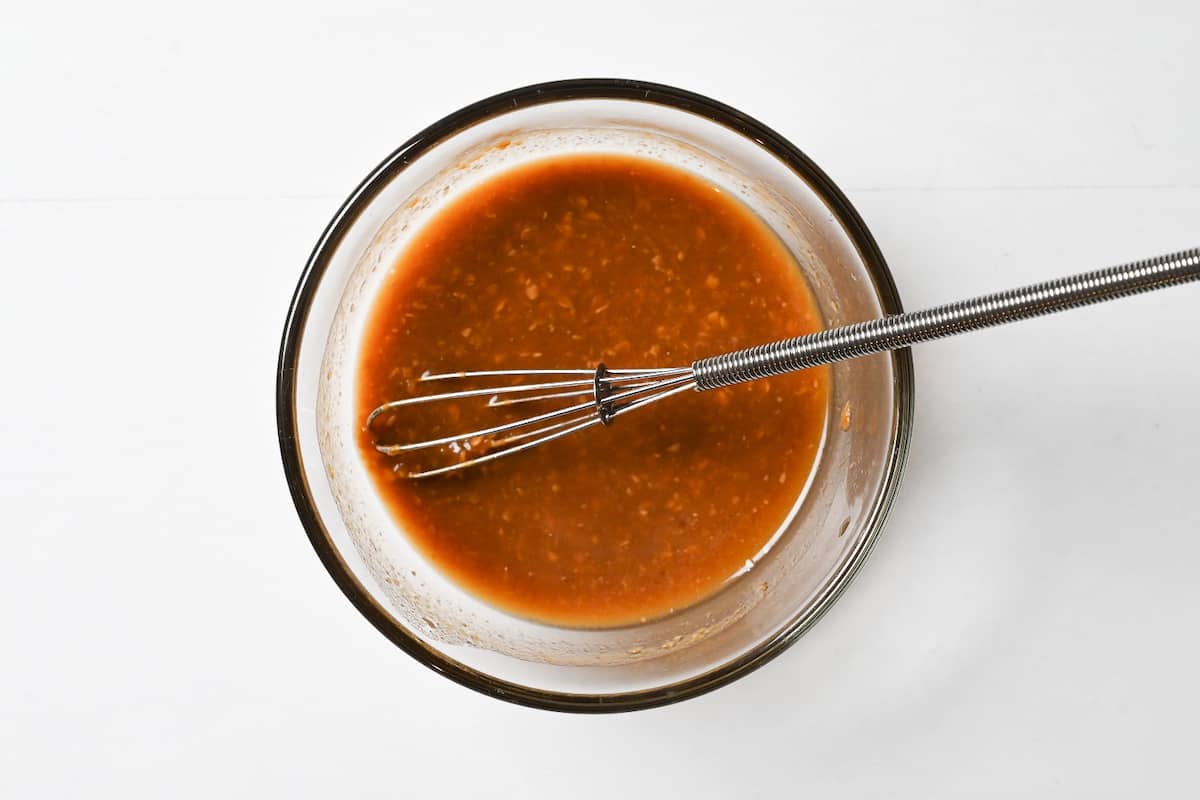
Add this mixture to the pan with the white part of leek and shishito peppers.
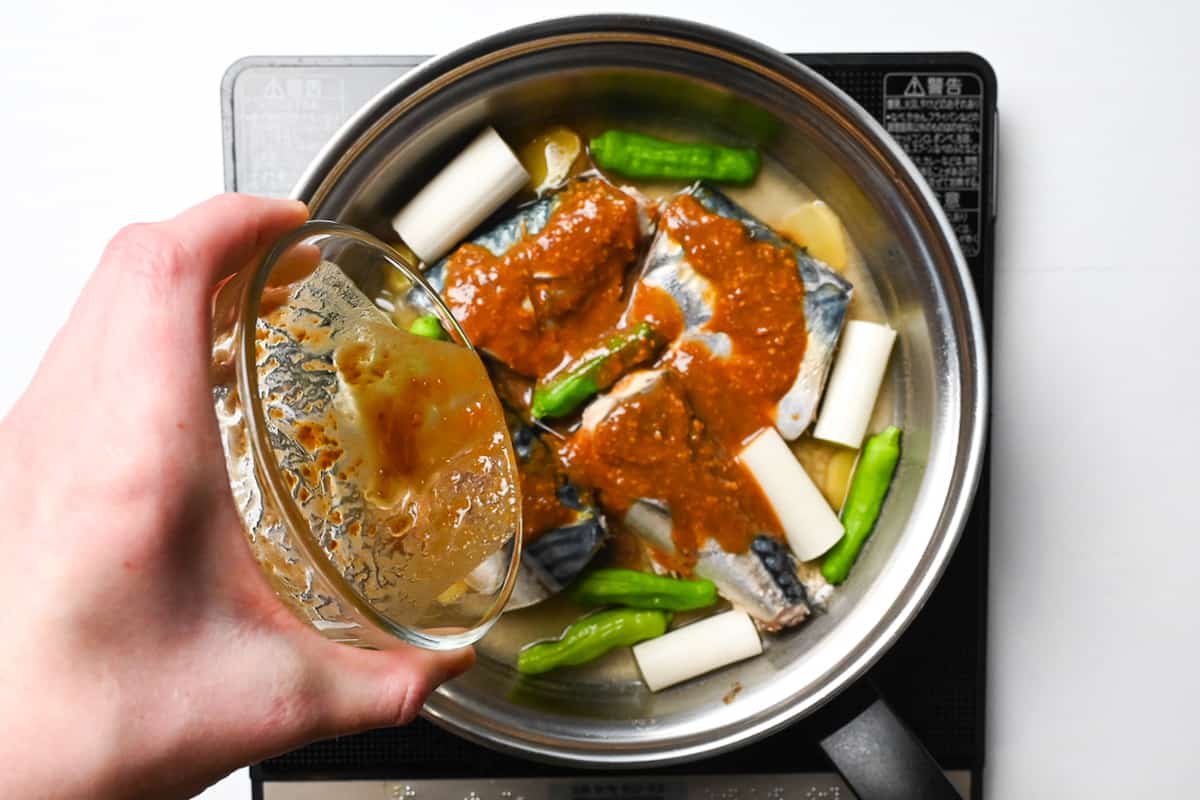
Continue simmering until the liquid reduces by half. Spoon the broth over the mackerel occasionally to keep it moist. This typically takes about 10 minutes, but you can adjust between 8-12 minutes depending on the size of your mackerel. The fish is ready when the flesh flakes easily.
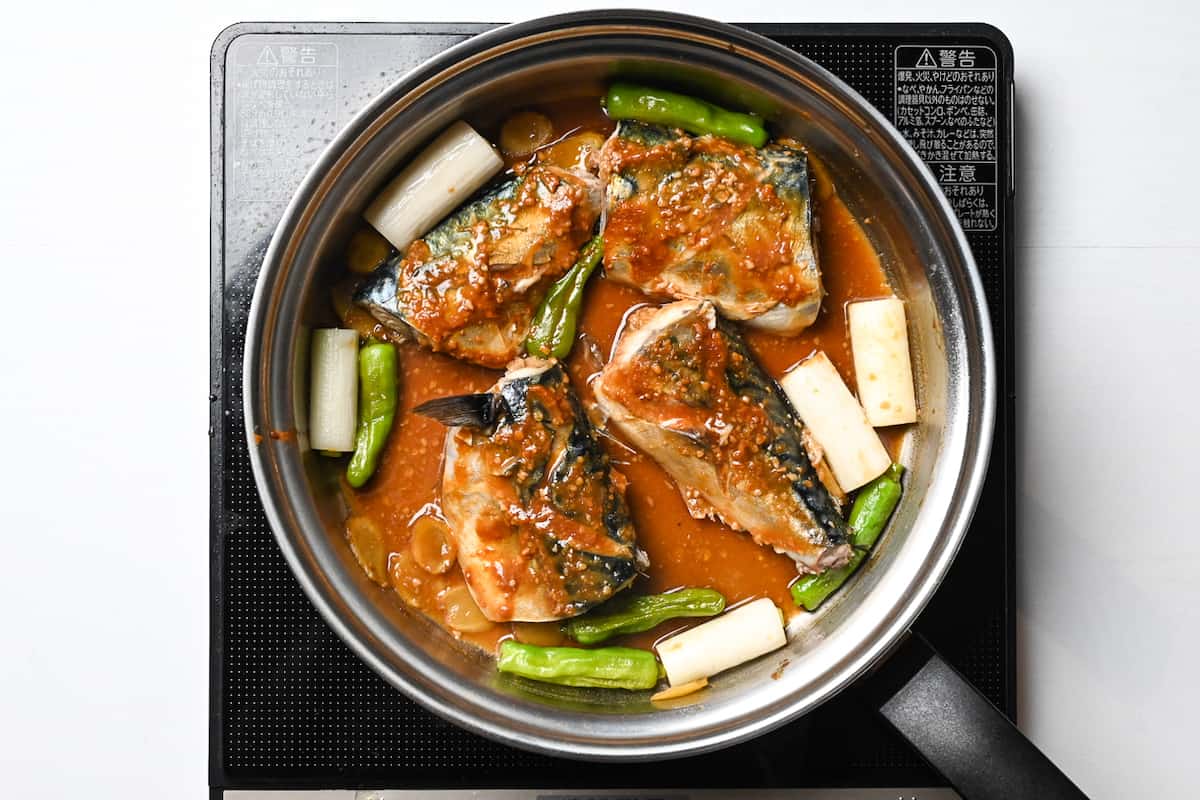
I mentioned this technique in my nikujaga recipe, but allowing the dish to cool down after it has been cooked develops the umami and richness of the sauce, resulting in the maximum flavor.
So, if you have time, it’s worth letting it cool down for about 30 minutes and then heating it up again to maximize the overall flavor. This resting period allows the fish to absorb all the delicious flavors in the sauce. It also makes this dish a good one to make in advance! But of course, this step is optional.
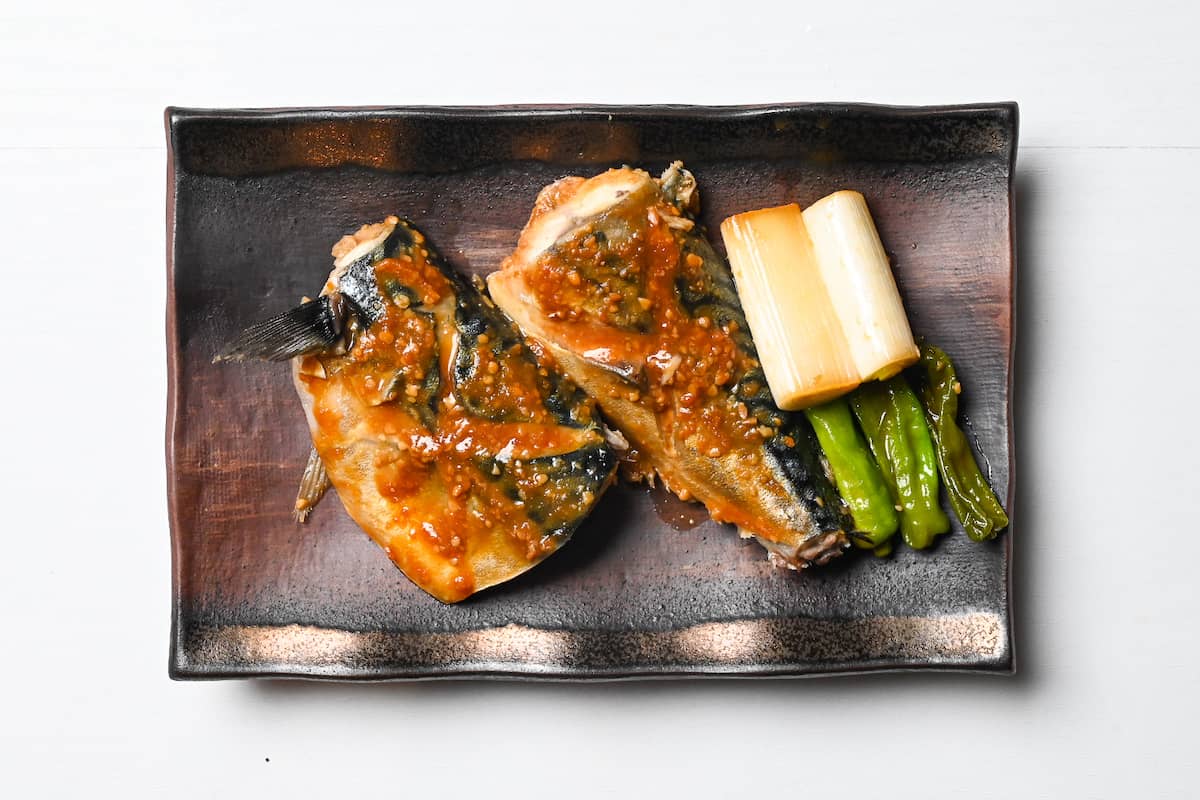
Place the mackerel on serving plates with the shishito peppers and a few spring onions. Drizzle some of the miso sauce over the top and enjoy with rice!
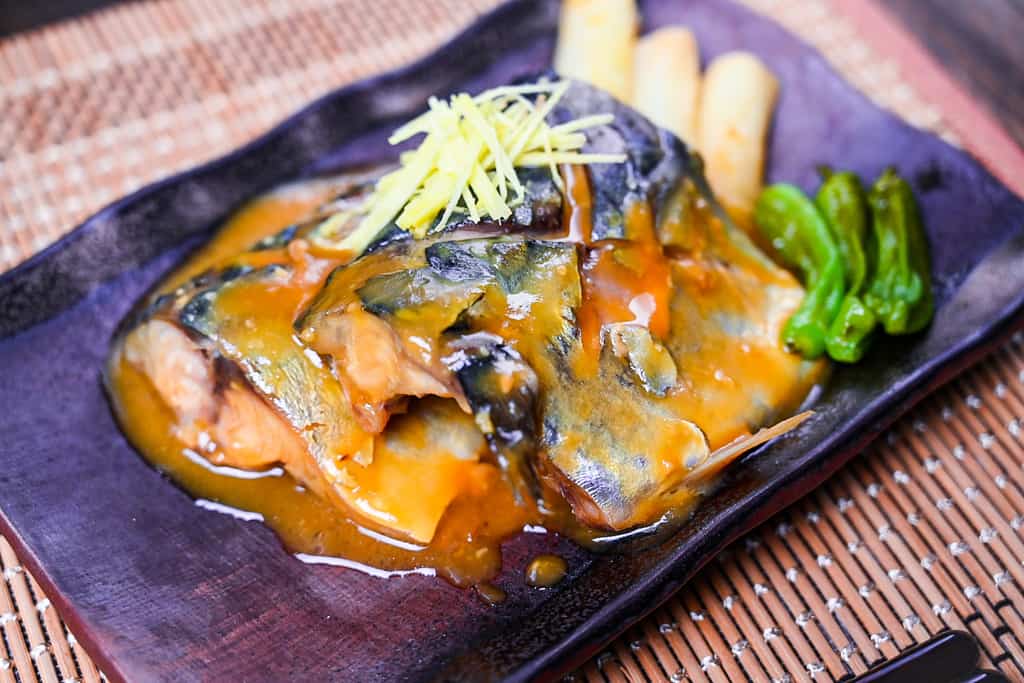
FAQ
For Saba no Misoni, I recommend using “Awase Miso” (also sometimes called yellow miso in English). You can also manually mix red and white miso paste at a 50/50 ratio to make your own awase miso.
When recipes on Sudachi mention “sake,” they refer to unsalted drinking sake, not the cooking variety. If you substitute with cooking sake, which contains salt, remember to adjust the recipe’s salt content to maintain balance.
A drop lid is indeed essential when making Saba Misoni. It ensures the limited cooking liquid distributes evenly throughout the fish and prevents it from breaking apart during cooking. If you don’t have a dedicated drop lid, you can easily make one from aluminum foil or parchment paper.
This is a technique used in many Japanese simmered dishes. By allowing the dish to cool after cooking, the ingredients slowly absorb the flavorful broth. Reheating further concentrates these flavors, resulting in a dish of remarkable depth and richness. However, if you’re pressed for time, you can skip this step and still enjoy a delicious meal.
Saba Misoni is usually served as the main dish in a traditional “Ichiju Sansai” (one soup, three dishes) meal structure. It is ideally accompanied by steamed white rice, miso soup, and 1-2 small side dishes such as pickles and vegetable preparations.
In fact, this dish is even better when made ahead! Refrigerate overnight or 1 day to allow the flavors to meld and develop more depth. When reheating, do so gently over low heat, and if the sauce has reduced too much, you can add a small amount of water to loosen it.
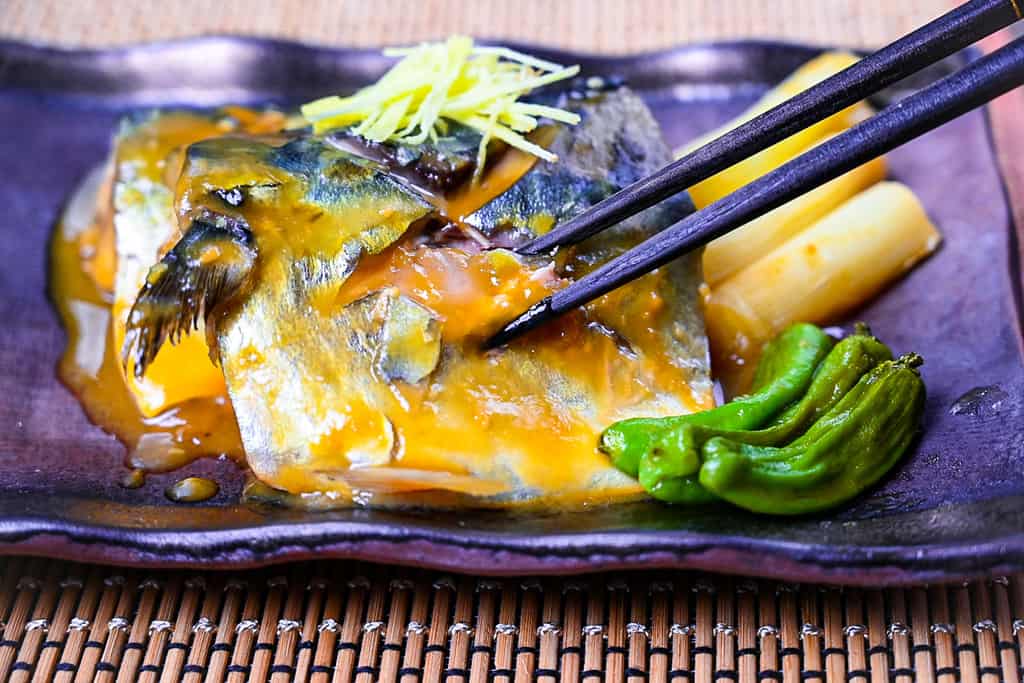
I hope you enjoy this Saba no Misoni recipe! If you try it out, I’d really appreciate it if you could spare a moment to let me know what you thought by giving a review and star rating in the comments below. It’s also helpful to share any adjustments you made to the recipe with our other readers. Thank you!
More Japanese Fish Recipes
- Saba no Shioyaki (Japanese Style Grilled Mackerel)
- Pan Fried Japanese Teriyaki Salmon
- Shiozake (Japanese Salted Breakfast Salmon)
- Miso Glazed Salmon (pan fried)
Hungry for more? Explore my fish recipe collection to find your next favorite dishes!

Simmered Miso Mackerel (Saba no Misoni)
Ingredients
- 2-4 mackerel fillets depending on the size
- water freshly boiled and ice cold for cleaning
- 150 ml water for cooking
- 150 ml sake
- 2 tbsp mirin
- 1 tbsp sugar
- 20 g ginger root sliced
- 2 tbsp yellow miso paste (awase)
- 2 tsp Japanese soy sauce (koikuchi shoyu)
- 50 g Japanese leek (naganegi) cut into 5cm pieces
- 6 shishito peppers optional
My recommended brands of ingredients and seasonings can be found in my Japanese pantry guide.
Can’t find certain Japanese ingredients? See my substitution guide here.
Instructions
- First, score 2-4 mackerel fillets with a cross on the skin side, about 2mm deep. The cut should pierce through the skin and lightly cut the flesh inside.

- Place the scored mackerel into a heatproof bowl and set a bowl of ice cold water next to it. Pour freshly boiled water over the top of the mackerel and wait for 10 seconds.

- Use tongs to transfer them immediately to the ice cold water and rub the surface to clean them.

- Remove them from the water and pat them dry with a paper towel.

- Take a large pan (big enough for the mackerel) and add 150 ml water, 150 ml sake, 2 tbsp mirin, 1 tbsp sugar and 20 g ginger root. Bring to a boil over a medium heat.

- Once the liquid is boiling, lower the heat to simmer and place the mackerel into the pan with the skin side facing up.

- Spoon the cooking liquid over the skin of the mackerel for about 1-2 minutes and then place a drop lid on top. Simmer for 10 minutes.

- Take a small bowl and add 2 tbsp yellow miso paste (awase), 2 tsp Japanese soy sauce (koikuchi shoyu) and 2-3 tbsp of hot cooking liquid from the pan. Mix well, you should have a loose miso mixture. (If it's too thick, add more liquid from the pan.)

- Remove the drop lid and add 50 g Japanese leek (naganegi) and 6 shishito peppers. Pour the miso mixture around the pan.

- Continue to simmer without a lid until the liquid is reduced by half. Spoon the cooking liquid over the mackerel from time to time to stop it from drying out.

- Transfer the mackerel to serving plates with the spring onion and shishito peppers. Pour a generous drizzle of the sauce and garnish with some finely sliced ginger from the pan. Serve with rice, miso soup, and pickles!

Notes
- This recipe also works well with other kinds of blueback fish such as as sardines or horse mackerel.
- Select fish with bright skin, clear eyes, and firm flesh for the freshest flavor—aim for 150-200g (5-7oz) per person.
- Add miso paste near the end of cooking and dilute it first in a small bowl with broth to preserve its flavor and ensure even distribution.
- For maximum flavor development, let the dish cool for 30 minutes after cooking, then gently reheat before serving.
- Store leftovers in the refrigerator for up to 1 day—the flavor actually improves as ingredients continue to absorb the sauce.
- Serve as part of a traditional Japanese meal with steamed rice, miso soup, pickles, and vegetable side dishes like spinach ohitashi or cucumber sunomono.



I made this as directed and it came out awesome. One of my fave comfort foods, now I know how to cook it myself. Mahalo!
Hi Ma’ata,
Thank you for the feedback! I’m glad you enjoyed the recipe, it’s one of my comfort foods too!
Yuto